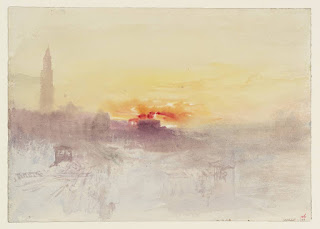John Ruskin's home in the Lake District sits high above Coniston Water, and early in June I made a visit there to see his home. I was not only able to examine and admire Ruskin's own works, but also a new exhibition, "Incandescence: Turner in Venice" from the Clore Gallery, Tate Britain.
Brantwood, overlooking Coniston Water, Cumbria
Brantwood sits in a wonderful spot and it is easy to see why Ruskin chose this place to be his last home from which to draw, paint and write. He adapted and extended his home to accommodate his own paintings, drawings and books, and to display his large collection of paintings by Turner. In the age of "Romanticism", Ruskin designed the rooms to maximise the views over Coniston and the surrounding mountains.
Ruskin was an important artist, art critic and writer. He was the leading English art critic of the Victorian era, an art patron and a prominent, influential social thinker and philanthropist. His ideas were at the forefront of ideas about environmental issues, sustainability and arts and crafts. The first volume of his book Modern Painters (1843) brought him to prominence and he was a lifetime admirer and supporter of J.M.W. Turner.
Brantwood, and the works of John Ruskin
In his lifetime Ruskin argued that the principle role of the artist is "truth to nature" and this theme is evident in the works on display. His work is varied and includes detailed studies of rocks, plants, birds, landscapes, and architecture. The exhibits include some of the original drawings and paintings which he used in his lectures to art students. In 1869 Ruskin became the first Slade Professor of fine Art at the University of Oxford where he established the Ruskin School of Drawing.
Ruskin J.
Lecture diagram: orange and Purple Leafspray (Buttercup (Ranunculus)
Pencil, chalk, watercolour, bodycolour on paper, laid on canvas
Ruskin's studies are inspirational for their detail and accuracy. His aim was to show the "relationship between form and underlying anatomy, physiology, growth and nature" (from Modern Painters by Ruskin). He believed that one learns through drawing, and said, “nor can the character of any tree be known until…not only its branches but its minutest extremities have been drawn.” I think that I can learn much from his philosophy.
Fringed gentian Gentianella ciliate
Ruskin's Bedroom, Brantwood
Ruskin surrounded himself with works by Turner, and Ruskin's bedroom walls were covered with a selection of Turner's landscapes.
Exhibition - Incandescence: Turner in Venice
The exhibition concentrated on a suite of watercolours from Turner's visit to Venice in 1840, the year in which Ruskin and Turner first met. Turner investigated many elements of his artistic expression through the exploration of light. The paintings on display portray the passage of light from dawn to dusk through a variety of views across Venice - an artist's paradise.
Writing about Turner, Ruskin said,
" At Venice he found freedom of space, brilliancy of light, variety of colour, massive simplicity of general form; and to Venice we owe many of the motives in which his highest powers of colour have been displayed."
JMW Turner, Venice at sunrise from the Hotel Europa, Venice
JMW Turner, Shipping off the Riva degli Schiavoni
JMW Turner, Venice: the Piazetta with the Ceremony of the Doge Marrying the Sea
Looking at the works I was impressed by Turner's fluid brushwork, his economy of form, and the use of light, both brilliant and subtle.
Summary and Learning Points
I found Ruskin's studies, landscapes, attention to detail and pursuance of the "truth of nature" inspiring. The visit was useful from a practical point of view, as it emphasised for me the importance of getting to know one's subject thoroughly by keen observation, drawing and studies.
The Turner Exhibition was significant in that I was able to consider and see first hand how to achieve different effects of changing light and moods through Turner's exceptional use of colour, space and form.
The visit was also significant in that it flagged up the way that Ruskin and Turner inspired each other, and how it is possible to learn from and be inspired by other artists.
As a result I was encouraged to find out more about both men.







No comments:
Post a Comment